Also - See photos and comments from other
CES & ICCE,
CinemaCon(Showest
),
CTIA,
SCTE |
| Get on our distribution list - click here |
|
|
 |
See the report on
CES Power Shifts
Click Here |
|
|
CES Pre-Show & Press Events |
|
|
CEA has a small side show two days before the main CES that shows off many
small companies, and a few big ones. With some exceptions, this
year's "CEA Unvieled" was dominated by phone and/or tablet oriented
peripherals.
Witness the HAPIfork from HapiLabs. It is only
appropriate that after the holidays, when all the diet ads appear on TV, we
now find a fork that helps you lose weight? How does it do so, you
ask? It times when you start and stop eating, how many bites you take
and how much time between bites. Plug this data into your App (USB
version in April, Bluetooth version in Q3) and you get an analysis that
helps you lose weight. Cheaper than other diet plans at $99.
|
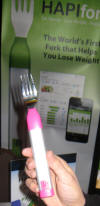 |
|
Lilliputian Systems can charge your phone 10 to 14 times
when you are on those long wilderness trips. The
fuel cell (cells are shown in photo) come in $10
cartridges and plug into a $299 base. Each cell
provides 55 Watt hours. |
 |
Anyone can go out and buy a fancy cover for their iPhone, but not everyone
has one that they designed themselves. Now you can be that person
with your own design. You download a free App from Sculpteo and
design your iPhone cover in 3D. Press "Send" and five days later you
have your own cover for $25 to $39, depending upon complexity. |
 |
 |
KubxLab sells a cover for your iPhone called the "AmpJacket" that passively
amps up the audio coming out of your phone. It sounded pretty loud,
even in a noisy room. $35. |
 |
Prefer the traditional Bluetooth type audio amplifier? This one is a
fairly compact unit. Sound quality was difficult to hear in the noisy
room. This speaker can clip to the back of your phone or stand up on
its own. Available Q2 for $99. |
|
While other phone controlled helicopters can fly around,
this one lets you "shoot" your opponent's helicopter.
Five shots and the helicopter is "dead". Or, if
you only have one helicopter, you can shoot at a table
target that shoots back. $70 per helicopter from
Beewi. |
 |
Alarm.com is one of the companies that has a phone oriented alarm and home
management system (lights, heating, too). Unlike the IRIS system sold
by Lowe's, the Alarm.com system requires a monitoring subscription ($40 to
$50 month). Installation can run about $150. One trick it has
is to adjust heating and lighting based on where you are. |
 |
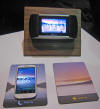 |
If you prefer to avoid the service fee and you only want to control your
HVAC, Allure Energy can seel you their Eversense system for $349. It
works with NFC-capable phones because the two pads you see in the photo let
you place your phone in awake and sleep modes. Seems a little
awkward, but perhaps control freaks would like it. |

 |
Shown here is the Sensus from Canopy Co. It is a phone cover that
adds touch controls to the back and sides of the phone case. At first
it was difficult to figure out what this was good for. But, consider
one app that lets one touch the back of the phone to type in braile.
Not sure if braile users would find this useful, but it is certainly
unique. Works with iOS, and is out this summer for $60. |
|
Atmel is partnering with Corning's Gorilla Glass to give
curved surfaces touch input. The system in called
XSense. It will be interesting to see what comes
out of this. Certainly, one can imagine kiosks,
etc. |
 |
Some people carry a phone only to use in an emergency. When such an
emergency happens, the battery is dead. This phone from SpareOne uses
one AA battery. You do not need a cell phone plan - it works with
anyone; but, it only calls 911 (or equivalent emergency number). A
new version adds a form of geotracking so that people can figure out about
where you are (it is not based on GPS) |
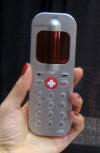 |
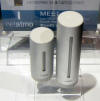 |
In case you are wondering, you can now read inside and outside temperature,
noise levels, barometric pressue, CO2, and even Air Quality from your
phone. Netatmo uploads all this to the cloud where you can see it
graphed out. $169 |
 |
The little blue device is a sensor that reads moisture, temperature,
lighting and fertilizer level. Sort of the equivalent of the Netatmo
device, but for your plant. This plant monitoring system will be
coming out later this year from Parrot, but no price has been set. |
|
OK, now for the device that any frequent flyer will have
to have. Trakdot will start to sell you their
Tracdot Luggage device for $50 and $13/year. It
tells you if your luggage made it to the same airport
you are in. If it didn't make it, it tells you
where it is. It is GSM based, so it works
worldwide. It turns on and off automatically, so
the battery lasts a "long time" and is compliant with
airlines. |
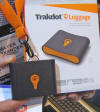 |
Sharp started with several minutes of explanation of how
their company is in good health with lower expenses,
etc. Hmmm...
That said, they showed one of the
more promising technologies - "IGZO" - Indium Gallium
Zinc Oxide. IGZO replaces the much slower
amorphous Silicon used for transistors in today's LCD
displays. IGZO is 20-40x faster and many benefits
result, such as more display area used for display
instead of transistors.
The photo is of their 4K
(32 inch) monitor that uses IGZO. Q1, $7.3K.
A version with touch comes out Q3 for $8.5K
No TVs use this
new process yet, but several phones exist in Japan. |

 |
Quite frankly, showing TVs in a photo is a challenge
because one cannot really appreciate them unless they
are seen in person. So, instead of photos of TVs
sporting OLED, Big 60 to 100" Screens, 4K (or 8K)
resolution, Gesture Controls, "Phone is your Remote",
LED matrix lighting, 3D, Apps (e.g. Netflix, Youtube,
Skype, Facebook, HSN, etc.), built-in 2.1 speakers,
etc., let us just say that the major CE vendors all
talked about having some combination of these features
in their "biggest lineup of TVs ever".
Note to TV
Marketing Staff - when you have over 20 models to cover
just 4 screen sizes (all in black),
the consumer no
longer understands what you are trying to sell them. |

 |
With TV sales and margins challenging major CE
companies, we are seeing more diversification in product
categories showing up at CES. As an example, the
item to the left is a new toaster from Panasonic.
Personal note: the first time I saw the Panasonic brand
was on my parent's rice cooker when I was a child.
As you can see, they still make them. I don't mean to pick on Panasonic here - LG, Samsung,
etc. are all trotting out appliances, some "smart", some
traditional, at CES. |

 |
Speaking of venturing out, Christie Street is trying to be a sort of crowd
sourcing version of Sand Hill Road for new product ideas. Products
must be physical in nature, like the doorbell shown on the left.
Christie Street helps to fund startups via pre-sales. For example,
they started last month with this doorbell and have generated $160K towards
a $250K goal. Christie Street keeps 5%. |
|
Are you a golfer that always slices the ball into the
weeds? Attach the Swing Tip to your club, hit a
few balls, upload the swing data into your tablet via
Bluetooth and see an analysis of your swing, including a
graphic view from different angles of your swing path.
$129, available now |
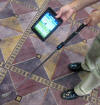 |
What sets this noise cancellation earphone set from the
others is that it connects to your player via Bluetooth.
They claim 95% noise reduction (but they didn't know
over which frequencies). Called the PS210BTNC, it
sells for $159. |
 |
 |
Invensas developed a chip interconnect technology to
help shrink memory boards in blade servers. Now
DELL is using this technology for tablets and notebooks.
The small board on the left holds the same amount of
memory as the PC board on the right (there are 8 chips
on this board, front/back). Not only is it
smaller, it is cheaper, saving about $20 in this case. |
 |
iMusic is doing a Kick Starter, trying to raise $50K, for this Body Rhythm
product. Listen to your music in a whole new way, with vibrations
that go with the music. They say it will go on the market for $169,
but a Kick Starter price is $69. |
|
Here is another do-it-yourself home security system.
The iSmartAlarm has a kit that includes what you see for
$250. Like the others, it uses the phone for the
UI, and Z-wave for device communications. |
 |
You wear this Lark Life on your wrist and it tells you
about your activity, suggesting that you do more
exercise, for example. A charge lasts 2 days and
it communicates to your phone via Bluetooth. $149 |
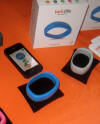 |
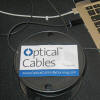 |
Corning got big on fiber optics, and now they are
applying their knowhow to optical cables for USB3 (30m)
and Thunderbolt (100m). HDMI is not yet available.
Pricing is TBD |
 |
Gamers look for every advantage they can get, including knowing every
shortcut key code in the game. Now, with the Logitech G600 mouse you
have an extra keyboard at the tip of your thumb for that extra competitive
edge, pun intended. $80 |
|
Ever try to sign an electronic document, particularly
one in PDF format (incidently, I needed to do this just
today). With DocuSign you just open the document
in their application and drag your signature to the
right spot. You can fill in other things, like
date, name, etc. Signing is free for the person
doing the signature, but the company that needs to read
the signed document pays a fee. There are 55,000
companies, they claim, that do so. |
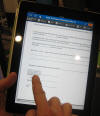 |
This line of watches from Martian works with your
smartphone to do all kinds of things. Use the
watch to secretly read text while driving (or better
yet, don't), hold coversations, take a picture from your
phone by pressing button on the watch, and all kinds of
tricky little tricks. Comes in various colors for
$149 to $299, starting in March |
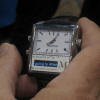 |
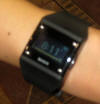 |
Another wearable body monitor here, this time from
BASIS. This measures a couple of unique things.
In addition to heart rate and motion, it reads
temperature and persperation. Works with Android
only, and communicates to the phone or tablet via
Bluetooth. $199 |
 |
This multipurpose gadget can be used to detect if your purse just moved, if
you phone was left behind, if your child just walked off, or if you
misplaced something. It is called the hipKey and it just started
selling in Apple stores for $90. A charge lasts about 2 - 4 weeks. |
|
Here is another body monitor. This one from
Zensorium is called the Tinke ($119) and it measures
breathing rate, blood oxygen, heart rate. It plugs
into your iPhone 4 (version for iPhone 5 comes later). |
 |
OK, I have to admit to wasting many a quarter on pinball
machines while in college. Now you can buy your
very own full scale pinball machine for just $2500 from
the people that make them for real - Stern. A
"professional" version of this same machine would cost 2
or 4 times as much. |
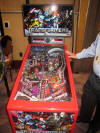 |
|
CES - Day 1 |
|
|
Having noted the Panasonic Toaster earlier, it is only fair to now talk
about their keynote address.
CEO Kazuhiro Tsuga's talk was a sort of
relaunching of the Panasonic brand. Yes, they showed some TV items,
but the bulk of talk was spent on the company's role in energy, automotive,
avionics and business products. Most people don't realize that
Panasonc has been a diversified company for many decades. As I said
earlier, my first memory of Panasonic as a child was of their rice cooker.
|


 |
Panasonic has been ramping up OLED research. They used the keynote to
show off their 56 inch, half inch thick, 4K OLED. Availability & price TBD.
By the way, the consumer name for "4K" is Ultra HD, or UHD - but we'll
use "4K" on this page.
Something you will be able to buy soon in their "MyTV" interface. It
uses facial recognition to bring up your personal home screen when you say
"MyTV". Your wall paper, choice of apps and links appear.
Expect this style of TV interface from everyone. In fact, Panasonic
just joined the Smart TV Alliance. |
TV's aren't only things that are looking more like
smartphones - Chevy is working with Panasonic on
"MyLink" which lets you put your choice of new Apps in
your car's dashboard years after you bought the car. Now
you don't have to buy a new car just to get the latest
features each year.
Also shown here are examples
of the LED lights Panasonic uses to light up the Tokyo
SKYTREE. |

 |
As a sample of their business oriented products, Panasonic showed a new 20
inch tablet with 4K resolution and touch/stylus interfact. The larger
size and higher resolution is something that some professionals will find
very useful.
 |

 |
 |
We move from the well established to companies that are barely off their
training wheels.
Here we have Cao Gadgets that wants to sell various
sensors that you can scatter about to measure temperature/motion, moisture
and current (0.1 amp resolution). The Temp/Motion sensor is $18.
Proprietary RF is used for communicate with a base station.
Now, if they
can just shrink these |
 |
A simple, yet useful product - BakBone is launching a way to hold your
tablet with one ring finger. This ring is magnetic and clicks onto a
magnetic disk that you glue to the back of your tablet, so you don't have
to have to have the ring attached all the time. Doctors and other
professionals might like this convenience. $35. |
|
If you've watched golf on TV, you see all kinds of fancy
graphics showing a player's shots, a live leader board,
etc. If you've played in a smaller tournament, you
are left in the dark. Now, with ShowMeGolfers.com
your club can bring a lot of these features to your own
home course. Players use the GSM device to mark
where they are and shots taken. Graphics showing
shots and leaderboards are automatically generated. |
 |
Max Virtual would like to sell, starting in March, a way for you to listen
to music without headphones. Instead, a pair of transducers are
mounted into your hat of choice and sound is picked up via your skull.
Strangely, you actually hear the music better when you plug your ears with
your fingers or something. You'll be able to buy a self-install kit
for $50, or buy one of their hats for $60. |
 |
 |
If you frequently suffer from jet lag, maybe you might benefit from
Re-Time's goggles. You wear these goggles for about 50 minutes in the
morning after your trip and it helps your body to reset its body clock.
They claim that it works and that customers in Australia swear by it.
About $275. |
 |
If you are visually impaired, like the person in this photo who is totally
blind, how do you text or deal with the QWERTY keyboard? Syntelia has
developed the Fleksy UI that you might think of as "T9 for QWERTY".
You can type by only touching keys that are close to the one you want and
the system figures out what you meant. Better than existing keyboards
that try to do the same. It optionally gives text to speech feedback
and has other gesture commands. It works with Android, and they hope
to get it into iOS. |
|
You know those little robots used by police and bomb
squads? Now you can own your own from Robotex. While the
two on the left are professional robots, the other two
cost just $299 (blue robot) and $499 for the one that
can climb stairs. |
 |
If you are into robots but prefer to have a little playful fun instead,
look at Modular Robotics. They have about 16 different types, each
with a preprogrammed function. Clear blocks provide action (e.g.
move, twist). Black ones have sensors (e.g. light). Colored
ones provide different functions (e.g. red is "negate"). You click
blocks together and they communicate with each other and work to do
different things. Also works with Legos. A kit of 6 starter
blocks is $160. A kit of 20 blocks is $520. |
 |
 |
This device from Freer Logic is called the Body Wave. In Q3
it will be available in a smaller
wrist band, reads you mind's wave patters (e.g. Theta
and Delta waves). From these readings it can tell
if you are paying close attention to something, or if
you are anxious about something, etc. It is used
to help in training, or to help people with attention
problems. It depends upon the application.
Versions cost $700 to $1800. Side note: if you
maintain a high level of Theta waves, meaning you are
paying close attention, you'll soon have to go pee. |
 |
Advertisers are always looking for ways to get your
attention. How about a touchscreen display that appears
to almost float in mid air? In fact, you can put your
finger through this display. The secret is that the
display is projected onto a "vapor wall". This display
costs $15K, from Displair |
|
Perpetua is located in Corvallis OR (where HP makes
inkjets). They are selling a polymer sheet (TEGwear )
that generates power from body heat. Depeding upon
the person and conditions, one might expect from 50 to
100+ microwatts. This power is just enough to
power small monitoring devices that might communicate
via a low power signal like Bluetooth. They don't
sell the end product, but various companies are using
TEGwear for theirs. |
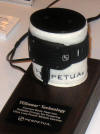 |
Bluetooth speakers are one of the hot topics this year.
in2uit has taken the next logical step and made a
stylish speaker that can be hung on a wall like art.
The 7 watt speaker's battery lasts 10 hours and costs
$299. |
 |
 |
Several robot arms were being shown. These arms
are another example of industrial capabilities that are
coming to the prosumer space.
The one of the left
is from RoadNarrows. It is a Beta unit because the
base still needs work. They call it Hekateros and
this 5 axis arm will sell for about $10K.
On the
right is the Robai from Energid. This arm has 7
axis and can lift about 1.5 kg. It also sells for
about $10K. A smaller arm can be seen in the back
that sells for $5K. |
 |
|
Earlier a helicopter that shoots down other helicopters
with a laser was shown. Here we have Combat
Creatures - land roving spiders with attachable weapons,
such as frisbee chips and plastic balls. You aim
for the legs. A hit makes them pop off.
These will be out this Fall for under $100. |
 |
Here we have another watch that works with your iPhone
via Bluetooth. All the usual features, such as
talk, mail, Facebook, Twitter, Instagram, weather,
stocks, news, etc. What makes these stand out is
their positioning. A gold version sells for
$17,000. The silver version (shown in photo) is
$2000. These watches come from I'm Watch |
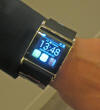 |

 |
Here is another product that reads your brain waves.
It comes from Neurosky. This one is a bit more of a toy. Your thoughts
control the helicopter's height. It is sort of
spooky when you see something physical being controled
by your thoughts. The kit sells for $189 and
includes the head band reader, helicopter and IR blaster
that talks to the helicopter. This company was
recently funded via KickStarter. |
 |
Tethercell has a product idea that will take a little
thought to come up with practical purposes for.
Note the one battery that looks different than the other
three. It is a AAA battery, while the others are
AA. The AAA battery is in a plastic shell that has
a Bluetooth controlled switch in it. From your
phone, you can turn the battery "on and off". In
this case, the light turns on and off. They are
using Indiegogo to raise $60K. |
|
Cra-Z-Art has come up with a winner. Their
LiteBrix are Lego compatible and add bright colors to
the things you make. Shown in the photo are some
of their soon-to-be-released products. Their
current line, more oriented to boys, sold out last
Christmas after only a few months. Kits cost
between $20 and $120. |
 |
ZBoard (zboardshop.com) has a powered skateboard.
Believe it or not, you can go 17 miles per hour on one
of these. The range is 5 to 10 miles, depending on
model. The 5 mile version is $650, and the 10 mile
version is $950. You control its speed by leaning
forward or backwards. |

 |
|
CES - Day 2 |
 |
Spent a little time amongst the big brands in the Central Hall today.
First thing one notices is that Microsoft (as they promised) is now missing
in action. The traditional spot they occupied is now taken up by
Hisense.
Korea and Japan are watching their rear-view mirror
closely now.
Just to show that they mean business in consumer
electronics, Hisense trotted out a full line of products, particularly in
TVs. Hisense can now co-claim to have the largest UHD LED TV,
measuring 110 inches diagonal. Not shown, but talked about next, is
an auto-stereoscopic TV. |
 |
|
As just mentioned, Hisense is planning on an
auto-stereoscopic TV. It will be based on their 4K
models because the technology comes from StreamTV.
StreamTV calls it Ultra-D. The technology was
designed by professor Walther Roelen in Eindoven.
Ultra-D does not use a traditional lenticular lens,
though there are some similarities. A four layer
optical screen sits on top of the 4K display. The
pixels are manipulated to form subpixels, and the
content is manipulated to match. They claim that
there are no sweet spots (unlike traditional lenticular
displays), but one will notice some ghosting and
wavering of the image when moving around. Also,
the 3D effect is optimized to a particular viewing
range. The overall results appear to be much
smoother than lenticular lens based displays.
Display resolution is also helped by the fact that it
starts with a 4K display. Hisense TVs using this
technology will come out about Q4 of this year, though a
TV based on a 2K display will come out in Q2. |
 |
 |
LG (Samsung, Panasonic, etc.) devoted much more floor space to major
appliances. In LG's case, perhaps a 30% of their booth was filled
with appliances.
The only thing of note here was the Tromm Styler.
This appliance takes the wrinkles out of you clothes and freshens them up.
Hotels use them. It costs $20K, and is only sold in Korea. No
plans for the U.S. yet.
LG seemed to lead the pack in other forms of
innovation, too. |
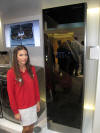
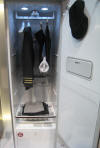 |
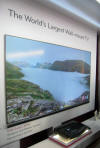 |
There were a couple of TV's to note in the LG booth.
The one on the
left is a 100 inch laser diode front projection TV with a 22 inch throw.
The projector is seen sitting just in front of the screen. The bar
under the screen is a sound bar.
This is an actual product that will
come out in March (price TBD). Interestingly, it uses a single DLP,
not three. |
The second TV to note is a 55 inch OLED TV with a curved screen. Why
curved? Someone said that it would give the viewer a more
encompassing viewing experience. The actual reason is to get your
attention. Also, contrary to the sign, this was not the only curved
OLED TV at the show.
Availability is tentatively "end of the year", and
no price yet. |
 |
|
LG also showed their "Pocket Printer", which will go on
sale in a few months for about $150. Put you
NFC-capable phone next to the printer and a 2x3 inch
photo pops out about a minute later. It uses
thermal printing, not inkjet, so you need to buy special
paper. |
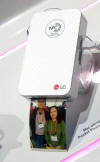 |
 |
Another clever LG product is their Ultrawide monitor with a 21:9 aspect
ratio. Aside from letting you view Cinemascope (2.35:1) movies, the
2560 x 1080 resoultion might come in handy for more practical purposes.
The display is 29 inches diagonal. Price is TBD |
 |
Finally from LG, this is their Smart Activity Tracker. It tracks
activity and location. It has a GPS and accelerometer. It links
via Bluetooth to your phone. Price is TBD. |

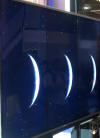 |
Here is Sharp's 90 inch LED LCD TV. Sharp's focus is on the larger
screens. When they start to apply their IGZO transistors to these
TVs, they will be worth a strong consideration.
Sharp also
demonstrated their "Moth Eye" coating. This coating reduces glare and
is said to be inspired by the moth's eye. The photo to the left has
the coating in the middle section only. You should be able to tell
the difference. |
|
One of the issues with 4K, of course, is the lack of
content. One stop gap solution is to process 2K
images to make them look 4K. The results can be
fairly effective. The Toshiba poster to the right
explains a number of tricks they are trying. |
 |
Here is another way to address the issue of 4K content - don't use
traditional cable, OTA or satellite providers. Many movies are shot
for showing in 4K today, so the trick is getting this content to the home.
So, Samsung and Netflix are playing with idea of "over the top" 4K movies. |
 |
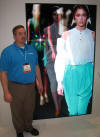 |
This gives you an idea of what a 95 inch TV (LED LCD) from Samsung looks
like when turned on its side for signage applications. The guy in the
photo said he is 6 feet tall. |
 |
And here is Samsung's 4K LED LCD 110 inch display. So, now as far as
the display size arms race, it is between Samsung and Hisense, in case
anyone is placing bets. |
|
Just for the record, here is Samsung's curved OLED TV |
 |
Also for the record, here is Sony's 56 inch 4K OLED display. You
might note that Panasonic showed their 56 inch 4K OLED display in their
keynote address. Sony and Panasonic collaborated on some of the
printing technology, but it appears that they did not jointly make the same
display. The two are actually different designs.
OLED still has a
poor reliability reputation, so it will be interesting what kind of prices
(price is one indicator) we eventually see. |
 |
 |
Canon has departed from several traditional paths with their new PowerShot
N camera. This camera appears to be aimed at the "cool shooter". As
you can see, the back touch panel display flips up, not to the side.
Old style viewfinder, if you will. Or, if you hold the camera upside
down, you could say it flips down. There is no shutter button. You
tap the display or part of the ring around the lens. The ring also
lets you adjust things. It has 8x zoom and 12.1 megapixels.
Available in April for under $300. |
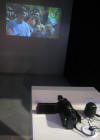 |
This is Sony's PJ790V combination HD camcorder and projector. This
updated model now sports 35 lumens. The claim is that it can project
a 100 inch diameter picture, though it is a bit dim when doing so. It
has an HDMI input, so you can use this to project content from your tablet,
etc. $1600 for this version, but lower cost models exist that are as
low as $350. |
Now for a couple of gadgets from smaller companies
Plenty of companies have robot vacuum cleaners.
Some might even have robot lawn mowers. But, you
have a robot wondow cleaner?
Evonacs wants to
sell you their Winbot for about $350, starting about
May. The photos show the front and back sides. |

 |
Instead of spying through those little wide angle viewers in the door, this
PeepHole Viewer from Brinno lets you see who is at your front door on a
small display. One model can even record what it sees when a motion
sensor or door knock triggers it. A future model will let you detach
the display and place it in another room (uses Wi-Fi). The
version in the photo sells for under $100. |
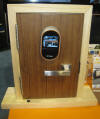 |
|
Day 3 |
 |
There was an early morning talk by Walt Mossberg for the HigherEd TECH
group. Walt started by observing that $60K/year for college is
unsustainable and immorale. But, throwing technology at the problem
is not the solution, and schools have proven resistant to change. There is
hope. New ways to think about "Time on Campus", Credentialing and Business
Models are starting, and lower cost tech will make some of this new
thinking possible. |
 |
A clever idea from Awox - build wireless 10W speakers into "40W" LED light bulbs.
Play music from your phone via Bluetooth ($99) or Wi-Fi ($149). This
product can be useful for some. It is currently monoraul, but stereo
is coming for the Wi-Fi version.
These can't be used for surround sound
because of latency issues. They can, however be sync'd to each other.
Europe sees these in May and the US later. |
|
Inside a plastic box, NVIDIA showed their "Project
Shield". This name is a placeholder until they
introduce it in a few months. It can plays Android
and PC games. You can use the builtin screen, or
wirelessly (with low latency) see the video on your TV.
Perhaps one of the more unique points about this product
is its business model. Most gaming platforms rely
on making money from game licenses. NVIDIA plans
to make money on just the hardware. Price is TBD. |
 |
If you are a camera buff you know about HDR, the combining of multiple
photos taken at different aperatures or speeds to get a high dynamic range
photo. NVIDIA has an parallel image processing approach that lets one
take an HDR photo in about 200ms, which minimizes blur between pictures.
HDR fans will want this in their camera. |
 |
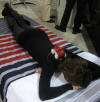 |
We have robots for vacuuming, cutting the lawn, washing windows - now one
to give you a massage. Whee Me will start selling these on Amazon in a
couple of weeks for $69. It also has a "Tickle Mode". |

 |
Nikon showed a new pair of interchangeable lens cameras, the S1 and J3.
The J3 (right) is 14 megapixel and has a mode dial - $599. The S1
(left) is 10 megapixels, has no mode dial - $499. These cameras are
shown with optional lenses. The J3 has a 10 - 100 (27 - 270 equiv),
4.0 - 5.6 lens that sells for $549. The standard lens that comes with
the camera is 11 - 27. Both use a 1 inch sensor. Available in
February.
The red camera is the CoolPix S6500. It has a 12x
optical zoom (3.1 - 6.5, so you sacrifice low light) and 16 megapixels. |
|
Earlier it was noted that Hisense and Samsung shared in
the display size race. I overlooked TCL, which
also has a 110 inch display. In fact, as one might
guess from their booth, this display was in the Ironman
movie and is "Tony Stark's choice". Of course,
neither is available in the real world yet. |
 |
Chris Pedersen pointed these out to me. LG has a scanner built into a
mouse. There is a long story behind these. HP actually invented
a similar scanner (project Zorro) over a decade ago, but it wasn't built
into a mouse - it was a separate handheld scanner that let you "swipe" the
page. The scanner can reconstruct the page by noting where the
scanner is on the page. How did this work? Well, it used
sensors that could see the paper's texture. The handheld scanner
failed in the market, so Gary Gordon in HPL applied it to make an optical
mouse. Now virtually every mouse uses this technology. What
goes around, comes around. |
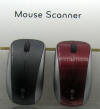 |
 |
Seems that there were dozens of watches that "work with your phone" at the
show. Here we have the Casio G-Shock. This one works with the
iPhone via an App you download. Relatively sparce functionality
compared to some. $180. |
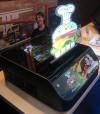
 |
This product from Casio shows more promise than the watch. The top
photo give a bit of a behind-the-scenes view. The cartoon figure
appears to be talking. The image is projected onto a transluscent
plastic that is cut out in the shape of the cartoon. Casio helps you
to create the graphics, but you can use a person, as seen in the 2nd photo.
Seeing these digital signs in person is very effective. You can
make them interactive, too.
These signs cost about $10K, but the LEDs
used in the rear projector have a 20,000 hour life. |
|
There are many LP to MP3 turn tables. This one from Ion
Audio is a bit unique because of its docking station for
the iPhone 4 and iPhone 5. These are only $129. |
 |
Parts of the North Hall of CES almost looked like you were in the Detroit
Auto Show. Full sized booths, like this one for Audi, were there from
most of the major brands. These were not the small booths of just a
couple of years ago, but in some cases duplicates of ones used in the big
auto shows.
When I first went to CES in the early 1990's the map showed
"mobile electronics". The term meant car stereos then. Later,
in the 2000's the term meant phones and MP3 players. Now we have gone
almost full circle, and the term applies to the car itelf. |
 |
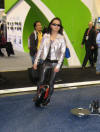 |
Here is a different mode of transportation. This came out a little
over a year ago - the Solowheel. One a single 1 hour charge you can
go 10 MPH for 10 miles. When you arrive, you pick up the 26 pound
wheel and pop into your office. It has a built in gyro to stabilize your
stance. It is quite amazing to watch someone just hop on and ride it
around. This is not a toy. It sells for about $1800. |
 |
Sorry, after showing the Solowheel I just couldn't resist including this
photo of a couple of gents riding their motorized wheelchairs. Turns
out someone is now renting these at the show and so these things were all
over the place. |
|
We end this day with a couple of "extreme" products.
Here we have the CompCooler from AD Technology. A
cooling unit that consists of miniature compressor (box
on right side, midway up) and heat exchanger (top of
case) pipes cool liquid to your CPU (middle left).
The unit has 300W of cooling power, allowing one to
crank up the clock. "Sample price" is $700. |
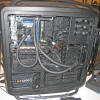 |
My son likes to brag about his super bright LED flashlight. I think I
found one that will challenge his claim. It comes from FourSevens.
It is 1,200 Lumens and you don't want to stare into it. Most of the
size and weight is in the copper that helps to keep the single diode cool.
Available for $259.
Update: my son points out the following -
Fenix |
 |
|
CES - Day 4 |

 |
Here is another way that 4K TV vendors are trying to deal with the lack of
content. When you buy Sony's 84" 4K LED LCD TV you get this 4K player
included, alond with a tablet that helps control it. The player comes
loaded with ten mainstream movies, plus some Indies and eye candy.
Sony will periodically send you a Blu-ray disc filled with more 4K content
for free. This free content service continues until a better solution
comes around (like Blu-ray players that can play 4K directly, and discs
that you can buy). Sony is offering this "generous" free service now.
Just buy their $25,000 TV first. |
 |
Sony was showing their Xperia Z phone. It has the usual things and is
based on Jellybean.
The one thing that might stand out is the 13
megapixel camera with HDR. They had a setup that let you compare your
phone with their phone in a low light setting. So, here is a photo of
an iPhone 5 using HDR compared to Sony's phone (right). The Sony
phone did look a little nicer, with less of a blue tint when compared to
Apple's.
Sony's phone comes out this Spring and price is TBD. |
|
Pentax is taking custom colors to a whole new level with
their Q10 camera. The cameras shown here have a 5
- 15 lens (2.8 - 4.5) and are 12 megapixel. The
lens is interchangeable. You go to the web and
pick the colors you want from a choice of 100
possibilities. $599 and a few weeks later your
camera arrives. |
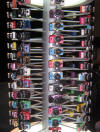 |
If you've every wanted to own a jukebox, Crosley will soon (mid-year) have
their model CR1205. This jukebox holds 100 CDs. It will sell
for about $10K.
If that is too expensive, you can buy the CR1205
that can play a single CD and has a AM/FM radio. You can also slip your
iPad into the front and play any music that you have in your iTunes (or
Pandara, Spotify, etc.) It is probably the fanciest iPad music
speaker that you can buy, and it costs only $1799. |
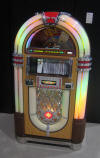
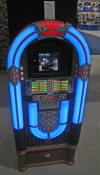 |

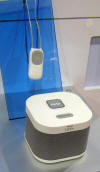 |
You've probably watched the "Help - I've fallen and I can't get up" ads.
One of the issues with these services is that they are limited to the a
range of rooms in the home. The service does not work if you are out
of range.
LifeComm (now part of Verizon) has a watch (top photo),
pendant or belt buckle that you can wear that uses the cellular network so
the wearer can be almost anywhere. It has a GPS and triangulation
assisted location. It can be a panic button and it can sense a fall.
Battery last 3 days. Roughly $100 - $200 and $40-45/month.
Philips
'Go Safe'
has upgraded their system in a similar way, though they can use their
home-based base station, too. The pendant has similar capabilities,
but it also has voice communication. Battery lasts a week and it has a
convenient cradle charger that lets you wear the pendant while charging.
$200 plus $50/month. |
 |
PSiO claims that wearing this device will put you into a hypnotic state and
in the course of 5 to 8 minutes you will be totally rested as if you had a
5 hour nap. It also cures Jetlag and helps you to remember things
better.
This fellow certainly looked relaxed.
You can
try to see if it helps you for $349. |
|
Time to buy a new monitor for your computer.
ViewSonic will be introducing this 32 inch 4K IPS
monitor later this year. Price is TBD |
 |
It is also time to buy a new car. Here we have an inside view of the
Tesla. This photo was taken in the NVIDIA booth because their Tegra
processor is driving the graphics. Note the size of the display. |
 |
 |
While traditional CE Mfrs move into Whirlpool's space, Whirlpool is playing
with some concepts in a completely different space.
Here is one
concept that they call the "Fireplace". It tries to make objects into
part of the conversation. When you place a cup on the table, for
example, you can twist the cup left or right and the lighting around the
cup goes from red to blue. It is suggested that the color signals if
the drink should be hot or cold, but one can imagine other things that the
color can signal - particularly at a bar.
A device in the cup is
read by the table, if you care to know. Don't expect this to appear
anytime soon, if ever. But, the concept fits perfectly here in Las
Vegas. |
Simply edit melody and words

click for
mp3 audio

These two played the music you hear with the synthesized singer |
Yamaha is taking synthesis to a new area - singing.
Starting in
March you will be able to buy a $135 program called
Vocaloid.
The photo shows a screenshot of the editor. You enter the melody and
words, plus some other data as needed. The result is heard as a
person singing the song that you just entered. It does not play the
music - that is done separately - but, their demo had a small band that
played music as the synthesizer sang the words. If you didn't know
it, you'd swear that it was a real person singing. Click the link to the
left to hopefully hear a crude recording made via a phone.
Yamaha
will also have companion product called Megpoid that synthesizes the voice
of singer Megumi Nakajima. |
We close the CES portion with something a little
different.
CES is constantly adding new market
segments to the show. Some of the recent market
segments include photography (with inclusion of PMA),
automotive, cable, digital cinema, health, and many
more. With so many new markets and companies, it
is hard for a company to get attention.
Here
is a sign from one new vendor that didn't seem to have
any trouble attracting attention.
At times the
line to this booth was quite long. |
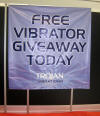 |
|
ICCE (International Conference on Consumer
Electronics) |
If you are not familiar with ICCE, think of it as the
R&D counterpart to the Marketing done at CES.
Why
would you care? Because the R&D folks are inventing the
stuff that you will see in future CES events,
only
they are talking about it now.
ICCE is run by the
IEEE Consumer Electronics Society |


 |
Microsoft Research's Mary Czerwinski gave a talk about "Effective
Computing", including summaries of several experimental projects that
explore the use of sensors and compute power to measure emotions. Shown
here is one try at measuring heart rate, skin conductivity and EKG with
sensors built into a bra so that the measurements could be made without
being visible to others (They tried men's boxer shorts, but couldn't read
the heart accurately). The 2x2 diagram on the left is used to chart
emotional intensity versus positive/negative emotions.
The
second photo shows a textured cloth wall that scrunches up when measured
emotions show tension. People see this and then watch the textured
cloth "relax", which in turn helps them to relax, too.
The third
photo is a "MoodWings" device that changes according to the tension
measured by the wearer. Can such feedback help drivers?
Particularly when such feedback seems to actually contribute to the stress?
These, and other experiments are aimed at seeing how such feedback
might help design better systems, environments and make better managers,
etc. Emotions are often thought of as the opposite of what computers
are about, so it is interesting to speculate how Microsoft plans to build a
business model around this research. |
Panasonic's Koji Morikawa talked about a "portable" EKG
system that doesn't need a gel to make good skin
contact. The key is an active electrode system
that can measure realtime reistance and compensate for
probe movement. The second photo compares active and
non-active electrodes.
Having such mobility and
portability opens up possibilities, such as more
accurate hearing aid fitting, sports training, and sleep
analysis. |

 |
Samsung is creating a way to clone facial expressions. They have
modeled the face to identify points that can be tracked on a real face.
These points are used to manipulate and avatar face in real time.
You might wonder what Samsung has in mind for this technology. They
say it is aimed at "better Smart TVs" |

 |
 |
Even though some may think that Samsung has moved on from working on 3D,
here is a paper that shows some of the research they are continuing to
fund. As you may see, 3D is a very tricky topic because the display is
trying to trick the brain into thinking it is seeing something that is not
really there. |
 |
This paper from Dong Wook Kim of Kyungpook National University talks about
making a hearing aid that can link to a smartphone via Bluetooth.
While the example shown here shows a simple volume control, it is
intriguing to imagine what other things one might do. Interestingly,
there were five papers, mostly from Samsung, on hearing aid research.
|

 |
Ronald Williams, CEO for Landmark Group, gave a very good talk that
summarized the state of 4K or Ultra HD TV in the industry. The slide on the
left hints at the complexity of getting everything right. It shows a
monitoring panel for the Sony F65, the newest (video) camera that can
handle 4K capture. Most people don't realize the number of "knobs"
that cinematographers can adjust. Not only does each captured frame contain
a table of metadata explaining camera settings, but the resulting video
then goes through all kinds of manipulation. For example, "LUT"
stands for Look Up Table, which is a matrix of numbers that tell people in
postproduction how color has been adjusted.
The second slide lists some
of the issues and directions that Ronald sees happening in the
industry in the future. This is a paper that would sit well at the
NAB, too. |
Each year at ICCE, Sony sponsors the IEEE Masaru Ibuka
award to people that have made significant contributions
to consumer electronics. This year's award when to
Martin Dietz, Kristofer Kjorling and Lars Lilyeryd for
the invention of AAC (standing left to right - sorry for
blurry photo - I was using a backup camera).
If
you've listened to music (e.g. iTunes) or watched many
forms of streaming video (e.g. MPEG4) chances are that
you were hearing audio that was sent via AAC.
The
second photo shows one of the original technical concept
diagrams that launched the work on AAC back in 1997.
The third photo shows a comparison of audio quality from
various audio codecs. Note where AAC is when
compared to MP3. |


 |
 |
Dr. Teichner, CTO of Germany's Loewe AG, explained where TV is going.
While much of his talk stated some obvious trends in the industry, the
slide to the left is a good summary of some of the challenges facing TV
manufacturers today. TVs have rapidly evolved from showing TV to
sophisticated displays that might be thought of as 60 inch tablets.
But, with one foot in the past (traditional TV services) and one in the
future (non-linear entertainment) the designers have plenty to do. |

 |
Even though ICCE is held in the U.S., papers are dominated by authors from
Asia, and some from Europe. Here we have a paper from Joshua
Benjestorf from NMC Corporation and University of California, Davis.
It explains a way to make a waterproof USB3 connector using capacitive
coupling. Such a connector might be useful for waterproof cameras, for
example. Interestingly, high frequency performance is actually better
then direct metal-to-metal contacts becuase impedence and reflections
issues are tamed. |
There was a lot of interest in gesture technology, the
ability of systems to recognize various hand and body
movements as commands. The Microsoft Kinect game
put this technology in the mainstream. Now
companies want to make everything you see Tom Cruise do
in the movie Collateral Damage come true.
Here we
have a paper from Samsung on how to get gestures
to work down to the level of the hand. In this
case, they talk about how to recognize if the hand is
open or grabbing. |

 |

